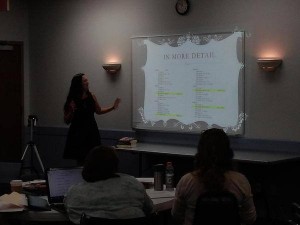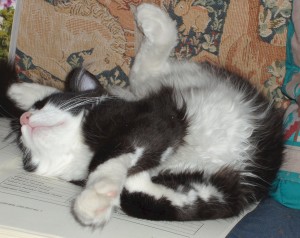
RITA ® Award-Winning Author of Fantasy Romance



Our topic this week at the SFF Seven is “The part of the writing process when I freak out.”
Which… it would be easier to pick a part of the process where we DON’T freak out. Writing seems to depend on freaking out in the same way stage performances feed on nerves.
But, I do offer my three typical freak-out moments – and why they’re not as bad as we think.
 A couple of weeks ago, I had the fabulous and fun privilege of flying out to St. Louis to teach a workshop to the Missouri Romance Writers of America (MORWA). They asked me to talk about structuring a serial novel, largely because of this terribly geeky blog post I wrote about it. (I think that’s a data point right there when people ask if writing blog posts is meaningful at all. Just saying.)
A couple of weeks ago, I had the fabulous and fun privilege of flying out to St. Louis to teach a workshop to the Missouri Romance Writers of America (MORWA). They asked me to talk about structuring a serial novel, largely because of this terribly geeky blog post I wrote about it. (I think that’s a data point right there when people ask if writing blog posts is meaningful at all. Just saying.)
In order to explain my method of structuring a serial novel, I started with the basic structure I use to structure any work. We talked quite a bit about the Three-Act Structure, where Act 1 is the first 25%, Act 2 is the middle 50%, going up to 75% through, with Act 3 being the final 25%. As with many RWA chapters – and one of the things I love about RWA – the members ranged from newbie writers stretching their muscles for the first time up to award-winning pros. So, as I was going over this structure pretty fast, in order to lay the foundation for the rest, I threw out that you know you’ve finished Act 1 because all the stakes are set. And that a solid first 25%, done correctly, will prevent the middle of the book from “sagging” or losing momentum. If you’re having problems with the middle 50%, go back and look at the first 25% and make sure you truly set all the stakes.
One of the newbies put up her hand and asked what that meant, to have the stakes set. Always a good reminder to me that stuff I take for granted at this point isn’t second nature to others.
I explained that the first 25% should introduce the characters, who they are, what they want and why they can’t have it. Some talk about the Three-Act Structure being that you get your protagonist up a tree in Act 1, throw rocks at them in Act 2 and get them down again by the end of Act 3. Setting the stakes is getting your hero or heroine firmly up in that tree.
So, I’m back home and fully plunged into writing THE PAGES OF THE MIND, which is Dafne’s book, the fourth in my Twelve Kingdoms series. In order to meet deadline, I’ve set myself what is for me a fairly grueling pace of 2,200 words/day, six days/week. As I have a full-time day job, that’s about the most I can do consistently. Some days I do more in the time I have, some days considerably less. The considerably less days are the ones where I circle back and revise or add to previous scenes. (Adding is nearly *always* involved.) I write my books beginning to end, so I really hate circling back like that. It feels like I’m not making progress.
I was getting all frustrated with myself this week about it.
Guess where I’m at? Yeah – 26,000 words, which for those who don’t speak math, is right at 25% of what will probably be about a 105,000 word book. (Most novels are 80,000-120,000 words. Fantasies like this can be on the longer end of the spectrum.)
It hit me sometime yesterday, that OF COURSE I’m doing a lot of circling back, layering and tweaking. I’m setting the stakes for the rest of the book! Once my Act 1 is solid, the rest will fall into place more easily. I know this. I freaking taught people about this a couple of weeks ago.
How easily we forget.
I’m feeling much better now!
Speaking of The Twelve Kingdoms, we’re kicking off the blog tour (heh – I first typed “bog tour,” which isn’t nearly so fun) for THE TALON OF THE HAWK. Today there’s a very juicy excerpt – one of my favorite scenes! – at the Chosen by You Book Club. Let me know if you like it, too. Hee hee hee.
Also, the Science Fiction and Fantasy Writers of America (SFWA) is starting a bimonthly (every two months, not twice a month) newsletter of members’ new releases. I think it will be great! You can subscribe here.
Have a great weekend everyone!
 Jackson demonstrates a little kitty yoga for you. Dare you to replicate this position.
Jackson demonstrates a little kitty yoga for you. Dare you to replicate this position.
I’ve been working away on the sequel to Rogue’s Pawn, simply titled RP2 for now. I had been going fast on it, then I slowed down. It happened right as I neared the Act I climax. Usually I don’t have this problem, but usually I’m not writing a sequel.
Now, for those of you not hugely up on story structure, most stories fall roughly into three acts. This is traditional, embedded-in-the-subconscious hum storytelling. Jokes traditionally come in three parts. Magic tricks have three stages: the pledge, the turn and the prestige. (Brilliantly demonstrated in the movie The Prestige.) Shakespeare’s plays generally are in three acts (if there’s an Act IV, it usually serves as an epilogue). You can think of it in the classic terms of “boy meets girl, boy loses girl, boy gets girl back” or “get your hero up a tree, throw rocks at him, get him back down.”
So, Act I for a sequel is all about getting my characters back up a tree. I say specifically “back up the tree” because I just finished getting them out of a damn tree in the first book. It’s not that easy to get them back up the tree without making them seem stubborn or stupid or just plain self-destructive.
Plus, in the sequel, you need to ground readers in the world and ongoing threads established in the first book so that they know enough to skip reading the first book, but not so much that readers of the first book throw the second one against the wall in frustration. (A reader recently told me she did this with the most recent book in an ongoing, very long series. She felt like every other paragraph was devoted to summarizing “the story so far,” to the point that would have thrown it against the wall, except she values her ereader.)
It’s a lot of stuff to fold into the first act. Especially if you want the story to be interesting, too.
I felt like I was up against a wall, in that final scene of the first act. I’d built and built up to that point, I had an idea what needed to happen, where everyone needed to be mentally, to catapult us into the rest of the adventure (hurtling rocks – coming right up!), but I just couldn’t seem to get it into place.
Now, some writers will switch off at this point. They’ll switch to another project or write a scene from later in the story. I can see why this works – it relieves the pressure of having your creative face mashed up against that plot wall.
But, for me, all the juice is in sticking it out.
I went back and reread what I had so far – about 100 pages – and tightened and polished as I went. I worked my way back up to that wall, my steps slowing with every page as I neared that final scene. Yes, it was painful and unfulfilling. The last 20 pages took me two days of sticking it out.
Finally, the wall crumbled.
The resistance gave way and the world on the other side opened up.
Juicy, indeed.